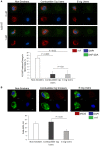Alterations in Vascular Function Associated With the Use of Combustible and Electronic Cigarettes
- PMID: 32345096
- PMCID: PMC7428567
- DOI: 10.1161/JAHA.119.014570
Alterations in Vascular Function Associated With the Use of Combustible and Electronic Cigarettes
Abstract
Background Electronic cigarettes (e-cigarettes) have been proposed as a potential harm reduction tool for combustible cigarette smokers. The majority of adult e-cigarette users continue to smoke combustible cigarettes and are considered dual users. The vascular impact of e-cigarettes remains incompletely defined. Methods and Results We examined the association of e-cigarette use with measures of vascular function and tonometry, preclinical measures of cardiovascular injury. As part of the CITU (Cardiovascular Injury due to Tobacco Use) study, we performed noninvasive vascular function testing in individuals without known cardiovascular disease or cardiovascular disease risk factors who were nonsmokers (n=94), users of combustible cigarettes (n=285), users of e-cigarettes (n=36), or dual users (n=52). In unadjusted analyses, measures of arterial stiffness including carotid-femoral pulse wave velocity, augmentation index, carotid-radial pulse wave velocity, and central blood pressures differed across the use groups. In multivariable models adjusted for age, sex, race, and study site, combustible cigarette smokers had higher augmentation index compared with nonusers (129.8±1.5 versus 118.8±2.7, P=0.003). The augmentation index was similar between combustible cigarette smokers compared with sole e-cigarette users (129.8±1.5 versus 126.2±5.9, P=1.0) and dual users (129.8±1.5 versus 134.9±4.0, P=1.0). Endothelial cells from combustible cigarette smokers and sole e-cigarette users produced less nitric oxide in response to A23187 stimulation compared with nonsmokers, suggestive of impaired endothelial nitric oxide synthase signaling. Conclusions Our findings suggest that e-cigarette use is not associated with a more favorable vascular profile. Future longitudinal studies are needed to evaluate the long-term risks of sustained e-cigarette use.
Keywords: electronic cigarettes; e‐cigarettes; smoking; vascular function.
Figures


References
-
- Rodu B, Plurphanswat N. E‐cigarette use among US adults: population assessment of tobacco and Health (PATH) study. Nicotine Tob Res. 2018;20:940–948. - PubMed
-
- Coleman B, Rostron B, Johnson SE, Persoskie A, Pearson J, Stanton C, Choi K, Anic G, Goniewicz ML, Cummings KM, et al. Transitions in electronic cigarette use among adults in the Population Assessment of Tobacco and Health (PATH) Study, waves 1 and 2 (2013–2015). Tob Control. 2019;28:50–59. - PMC - PubMed
-
- Silveira ML, Conway KP, Green VR, Kasza KA, Sargent JD, Borek N, Stanton CA, Cohn A, Hilmi N, Cummings KM, et al. Longitudinal associations between youth tobacco and substance use in waves 1 and 2 of the Population Assessment of Tobacco and Health (PATH) Study. Drug Alcohol Depend. 2018;191:25–36. - PMC - PubMed
-
- Benjamin EJ, Virani SS, Callaway CW, Chamberlain AM, Chang AR, Cheng S, Chiuve SE, Cushman M, Delling FN, Deo R, et al. Heart disease and stroke statistics‐2018 update: a report from the American Heart Association. Circulation. 2018;137:e67–e492. - PubMed
-
- Burns DM. Epidemiology of smoking‐induced cardiovascular disease. Prog Cardiovasc Dis. 2003;46:11–29. - PubMed
Publication types
MeSH terms
Substances
Grants and funding
LinkOut - more resources
Full Text Sources
Medical
Research Materials

